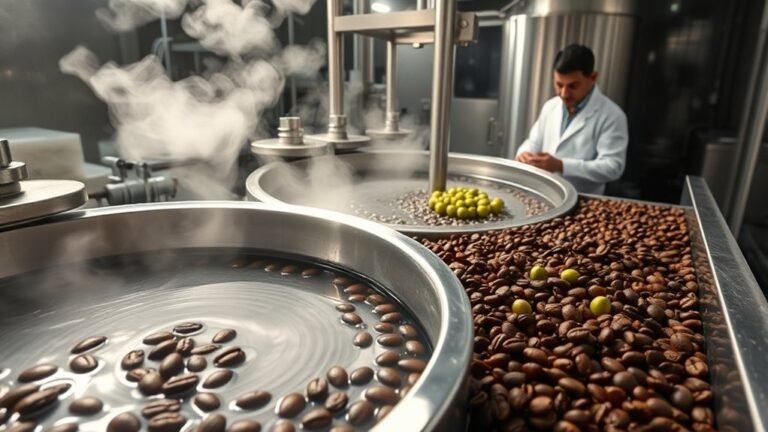How to Read a Coffee Bag: A Guide to Labels and Certifications
When you check a coffee bag, focus on the origin and roast date to assess freshness and flavor notes shaped by geography. Certifications like Organic and Fair Trade reveal ethical farming and equitable trade practices. Roast levels—from light to dark—indicate flavor profiles suited for different brew methods. Specialty grades with quality marks assure superior standards and minimal defects. Understanding these details empowers you to select coffee that matches your taste and values. Keep exploring to unravel deeper insights behind these labels.
Understanding Coffee Origin and Roast Dates

Where exactly does your coffee come from, and why does the roast date matter? Knowing the origin characteristics is essential; coffee beans’ flavor profiles vary dramatically based on geography, altitude, and soil composition. Regions impart distinct acidity, body, and aroma, so understanding origin allows you to anticipate the taste. Equally important is roast freshness, indicated by the roast date on the bag. Coffee begins to lose volatile compounds immediately after roasting, diminishing flavor complexity and aroma. You want to consume coffee within two to four weeks from this date to enjoy ideal freshness. By focusing on precise origin characteristics and prioritizing roast freshness, you retain control over your coffee experience, ensuring every sip aligns with your quest for flavor freedom and quality.
Decoding Organic and Fair Trade Certifications
Certification labels like Organic and Fair Trade on coffee bags serve as more than marketing tools; they represent specific standards in cultivation and trade practices. When you see these certifications, you’re choosing coffee produced through rigorous methods:
Certification labels on coffee reflect strict standards in cultivation and ethical trade practices.
- Organic farming avoids synthetic pesticides and fertilizers, promoting ecological balance and soil health.
- Fair trade practices guarantee farmers receive equitable compensation, enabling sustainable livelihoods.
- Both certifications require third-party verification, assuring compliance with strict environmental and social criteria.
- These labels empower you to support ethical production, preserving biodiversity and human rights.
Exploring Coffee Roast Levels and Flavor Profiles
Although the origin and cultivation of coffee beans are crucial, understanding roast levels is essential to grasp how flavor profiles develop during roasting. Light roasts preserve the bean’s intrinsic flavor notes and acidity, often highlighting floral and fruity tasting profiles with pronounced aroma characteristics. Conversely, dark roasts diminish origin-specific flavors, emphasizing bitterness and smoky, chocolatey tones. Recognizing these distinctions allows you to select a roast that complements your preferred brewing methods—light roasts excel in pour-over or drip techniques, while dark roasts often suit espresso or French press. By decoding roast levels on a coffee bag, you gain insight into the expected sensory experience, enabling you to tailor your choice to your palate and brewing style, thereby ensuring a satisfying and liberated coffee ritual.
Interpreting Specialty Coffee Grade and Quality Marks

Understanding roast levels gives you a foundation, but evaluating the quality of coffee starts with recognizing specialty coffee grades and quality marks on the bag. These specialty grades are strict quality indicators assigned after rigorous sensory evaluation. When you see a bag labeled with such marks, it guarantees a superior coffee experience. Here’s what you should look for:
- Score-Based Grades: Specialty coffee must score 80+ points on a 100-point scale by certified Q graders.
- Defect Counts: Bags often indicate the maximum allowable defects, typically zero to five for specialty.
- Origin and Traceability: Precise farm or cooperative details reflect controlled quality.
- Processing and Harvesting Notes: These notes reveal meticulous handling practices essential to the coffee’s quality.
Tips for Choosing Coffee Based on Labels and Certifications
When selecting coffee, you’ll want to pay close attention to the labels and certifications displayed on the bag, as they provide critical information about the coffee’s sourcing, ethical standards, and production methods. Look for certifications like Fair Trade, Rainforest Alliance, or Organic, which indicate adherence to sustainable sourcing and ethical practices. These labels guarantee that the coffee was produced with environmental stewardship and respect for farmer livelihoods. Additionally, certifications related to biodiversity conservation or carbon neutrality further confirm a commitment to sustainability. By choosing coffee with these verifiable marks, you’re supporting transparent supply chains and responsible production. Prioritize bags that clearly state origin details and certification bodies, as these details empower you to make informed decisions aligned with your values of freedom and responsibility in consumption.
Frequently Asked Questions
How Should I Store Coffee After Opening the Bag?
Did you know coffee starts losing its freshness within minutes of exposure to air? For ideal coffee storage after opening the bag, transfer beans into an airtight container to minimize oxygen exposure. Keep your container in a cool, dark place away from heat, light, and moisture to preserve flavor and aroma. Avoid refrigeration, as condensation can degrade quality. These freshness tips guarantee you enjoy your coffee at peak flavor, granting you the freedom to savor every cup.
What Do the Numbers on Coffee Bags Mean?
The numbers on coffee bags often indicate roast level, grind size, or origin codes, which directly impact your brewing methods and flavor profiles. Understanding these lets you tailor your brew—for example, a finer grind suits espresso, while coarser works for French press. Roast level numbers hint at acidity and body; lighter roasts preserve brightness, darker ones deepen richness. By decoding these numbers, you gain freedom to customize your perfect cup.
How Long Can Coffee Stay Fresh in the Bag?
Imagine your coffee losing half its aroma within just two weeks after roasting. The freshness duration of coffee in a sealed bag is typically around one to two months, depending on the packaging and roast date. After this, coffee aging begins, causing flavor degradation. To savor prime taste and freedom from stale brews, consume within this window or store beans airtight, away from light and heat, preserving that fresh, vibrant profile you crave.
Can Coffee Bags Be Recycled or Reused?
You can recycle coffee bags, but it depends on the coffee bag materials. Most bags combine plastic, foil, and paper layers, making them tricky to recycle through regular curbside programs. You’ll need to check local recycling guidelines to see if multi-layer packaging is accepted. For reuse, you might repurpose bags for storage or crafts, extending their life. Understanding materials helps you make eco-friendly choices without sacrificing your freedom to enjoy great coffee.
What Is the Difference Between Single-Origin and Blended Coffee?
When it comes to coffee, you can’t judge a book by its cover. Single-origin coffee comes from one specific region or farm, offering unique single origin benefits like distinct flavor profiles and traceability. Blended coffee, on the other hand, combines beans from multiple regions, creating complex and balanced blended flavors. You get the freedom to choose between pure terroir expression or a crafted harmony, depending on your taste preference and adventurous spirit.






